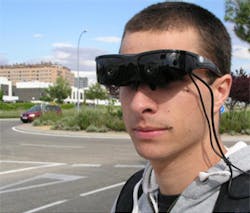Prototype goggle-based system aids the visually impaired
Spanish researchers at the Universidad Carlos III de Madrid (Madrid, Spain) have developed a prototype system that could be a useful aid to individuals with visual impairments caused by medical conditions such as glaucoma.
The prototype system -- which looks like a pair of goggles -- sports two cameras and a pair of displays. These are connected to a pocket-based computer system running a custom-built algorithm developed by the researchers.
In use, the algorithm measures the outline of the objects in the field of view and their distance from the user, and communicates the information to the user by displaying the data on the two in-built screens, highlighting the silhouette of the elements in the scene and varying their colors according to their distance.
Currently, the system is being tested in collaboration with the Institute for Applied Ophthalmology at the Universidad de Valladolid (Valladolid, Spain) where clinical tests are being carried out on a sample population of patients with visual impairments.
Once the results of the testing have been carried out, the researchers at the Universidad Carlos III de Madrid will be able to evaluate the success of the system and improve upon the ergonomics of the system.
On a related note, an Edinburgh University (Edinburgh, UK) spin-out has developed what it claims is the world’s first visual field analyzer for patient groups whose visual field was previously impossible to test, including young children and vulnerable adults.
The i2eye Diagnostics (Edinburgh, UK) system harnesses the patient’s natural reactions to movement and light to analyze their visual field without any need for them to keep still, understand the test or give feedback to the tester.
-- by Dave Wilson, Senior Editor, Vision Systems Design
